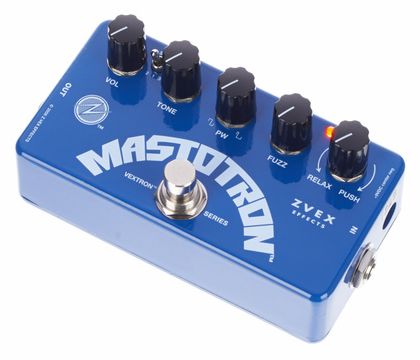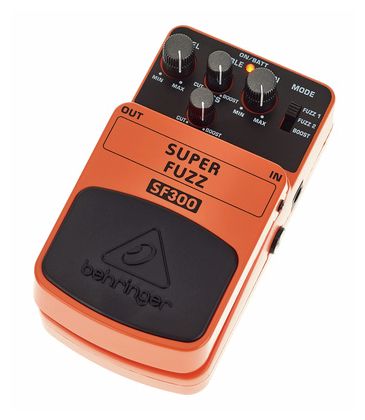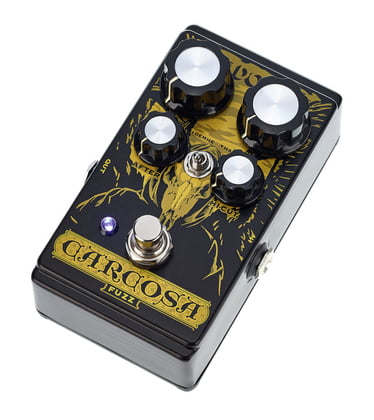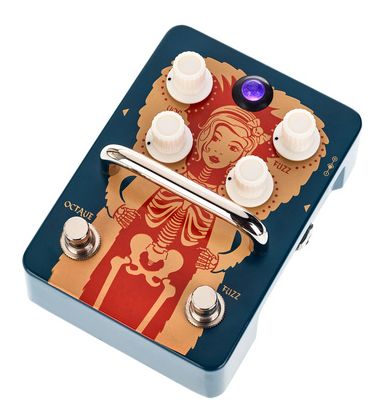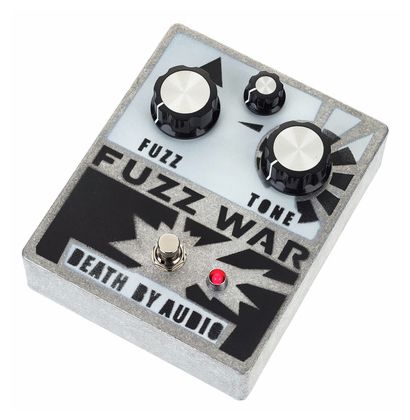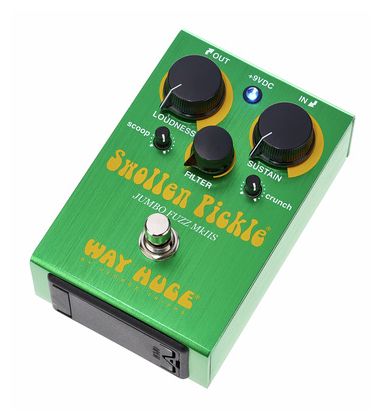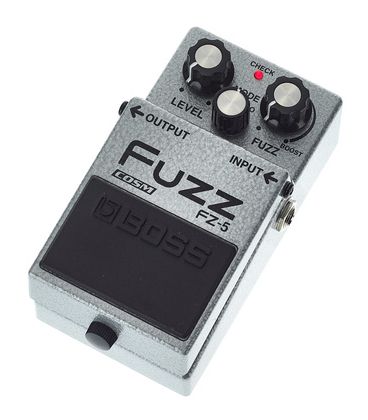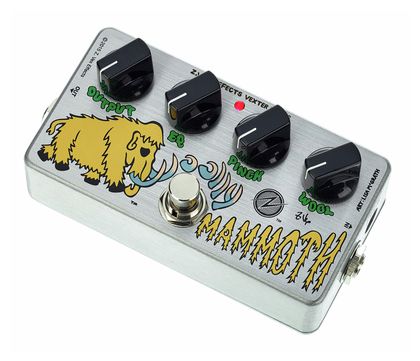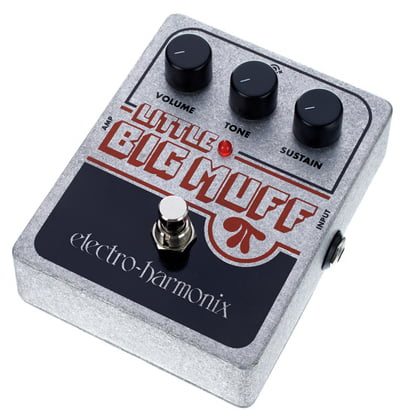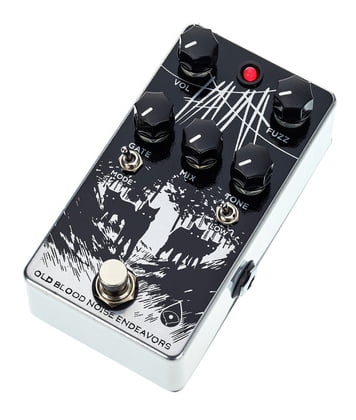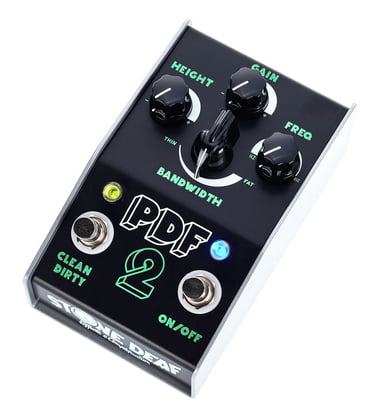Want to find a Fuzz pedal to add a massive wall of distortion to your band’s sound? Here is a list of the 12 Best Fuzz Pedals For Metal 2024 (Doom, Sludge, Stoner & Death).
It is generally agreed that guitarist Grady Martin used fuzz for the first time in the famous song Don’t Worry. This intense, square-wave distortion resulted from an error in a mixing console, which inspired engineer Glenn Snoddy to duplicate the ‘mistake’ in a standalone device utilizing three germanium transistors, as is the case with most of the best things in rock ‘n’ roll.
Gibson purchased the rights to the design and released the Maestro FZ-1. The most sought-after models of Fuzz Faces, Tone Benders, and Muffs trace their lineage back to this invention, and they all use germanium transistors at their core.
However, due to their inconsistency and extreme sensitivity to temperature, germanium transistors were quickly replaced by silicon transistors.
Nowadays’ metal has a fuzzier, thicker sound than it did in the ’90s, with guitar tones that recall early Black Sabbath. Many guitarists may find the crisp high-gain crunch produced by a Metal Zone or similar pedal unappealing because it is too harsh and has an unnaturally high level of gain.
Instead, many up-and-coming metal guitarists today look for thickly-voiced fuzz boxes or effects that straddle the fuzz, distortion, and overdrive soundscapes in search of heavier lows, mellowed highs, and front-end saturation akin to that of a cranked vintage tube amp with a treble boost pedal.
What Does a Fuzz Pedal Sound Like?
The Fuzz tone is an overdriven guitar signal that transforms the note into a simple square wave with huge sustain. A signal is amplified by two, three, or more transistors until it becomes distorted and fuzzy and has an extremely long sustain.
Due to production inconsistencies and malfunctioning germanium transistors, silicon eventually substituted germanium in later generations. Additionally, silicon transistors sound brighter than germanium transistors while offering more gain.
Where Does Fuzz Pedal Go in Chain?
It would be best to use overdrive and distortion pedals after the fuzz pedal because these pedals have the most significant impact on the tone; hence they should be placed early in the chain, and the final pedals, such as reverb and delay, can polish the sound better.
This is due to the strong relationship between the fuzz pedal’s effect and the volume knob on your instrument; when the volume is turned down low, the fuzz pedal is unable to do its work, but when it’s turned up high, you can hear it. Since the fuzz pedal is most easily controlled when it is closest to the guitar, placing it there makes the most sense.
Why Are Fuzz Pedals So Expensive?
Fuzz pedals are expensive because some are made with authentic, long-since-obsolete parts. It is also necessary to measure and match components by hand for some fuzzes. If this is in sync with the introduction, it will be necessary to invest time and money into the meticulous effort.
Due to these factors, constructing certain fuzzes is legitimately challenging and expensive. However, good quality components, well-built pedals, and enclosures rapidly add a lot.
12 Best Fuzz Pedals For Metal 2024 (Doom, Sludge, Stoner & Death)
1. Z.Vex Mastotron
The Mastotron’s push/relax dial makes it ideal for guitars, basses, and keyboards. It can be configured to work with passive pickups, active pickups, or a line-level signal.
The ZVex Mastotron Effects Pedal is a silicon-based fuzz pedal featuring a wide variety of tweakable parameters, including tone, volume, fuzz, pulse width, and relax/push. In addition, you can adjust the input impedance of the pedal with the relax/push switch.
If you are re-amping a bass off a recorded file, you can turn the effects pedal knobs to relax for special effects and line-level signals. This is also useful if you want quieter pickups, softer guitars or if you have just installed active pickups.
Key Features:
- Relax/Push
The source impedance can be changed using the final knob labeled “Relax/Push.” Overcompressed and insensitive tones are common for players employing distortion and fuzz pedals with active pickups in their instruments.
Sounding flat and muffled is sometimes the result of active pickups’ stronger signal or flatter frequency response compared to a passive pickup. The input impedance is reduced when the Relax/Push knob is turned to the left, which “softens” it, as described by Z.Vex, for use with active pickups.
Passive pickup users of the Mastotron should turn this knob to the right for the best sound.
- Tone
This knob is a treble-shaping tone knob but greatly impacts the overall sound. For example, a bubbly, fuzzy noise is produced when you turn it to the clock. On the other hand, the less high-end you have, the more delicate and smooth the sound becomes, which is often quite pleasant.
- Subs Switch
When turned down to 1, the sound is thin; however, this is not always a drawback. You can use the first setting to generate some excellent 8-bit-style sounds. The bass is thicker and more audible on the second setting, while there is still not a lot of fuzz, and the third setting is just massive.
Character & Sound:
In contrast to many other fuzz boxes on the market, the Zvex Mastotron’s tone is very thick and fuzzy, but it has good tracking, and users can easily understand the sound musically. With this, you may attain a deep, crunchy, yet almost clean and precise fuzz tone.
It has a contemporary sound, but you can still play with it quite a bit because of the many controls, including the classic ones like volume and pan, as well as some novel ones like relax/push (impedance) and sub-frequency adjustment.
Pros:
If you want a fuzz/distortion box that’s more flexible than the ordinary pedal and gives you more control, look no further. It’s not the cheapest pedal on the market, but neither is it the most costly, making it a great value considering its versatility and sound quality.
Cons:
Several consumers have complained that the pedal stopped working after only two hours of use, noting the pedal’s low output level and the fact that it broke rapidly. Of course, some pedals may be immune to these issues; nonetheless, you may be assured that you can return or exchange your purchase on most websites.
2. Behringer SF300 Super Fuzz (Cheap & Great)
This pedal was made to replicate a wide range of powerful fuzz tones, typically heard in classic rock, allowing you to follow in the footsteps of guitar greats like Jimi Hendrix.
The SUPER FUZZ SF300 is the next step in your musical evolution if the primal force of the most desired stomp boxes in history has you itching to plug in, turn on, and rock out. This pedal has separate Gain, Level, and 2-band EQ knobs for classic fuzz, grunge, and gain boost.
Key Features:
- Three Way Switch
The Mode switch, which has three positions, is the main feature of this device. Select one of the three predefined levels of super fuzz sound here. Jimmy Hendrix-esque classic fuzz grunge and gain boost are what you get with Super Fuzz 1, while the grunge sound you get with Super Fuzz 2 is acidic, unclean, and ready for some QOTSA.
The gain boost increases your guitar’s overall volume, and you can even go into overdrive with your amplifier with this setting.
- Knobs
The Level knob can be called Output or Volume and is used to modify the overall volume of your music and the amount of distortion it contains. The higher it’s raised, the less clean the guitar tone and the more overdrive you’ll receive.
A warped, fuzzy, and heavy sound results from turning up the Gain knob, one of the main components of distortion. The Treble and Bass control lets you adjust the audio spectrum’s high and low ends. It’s pretty normal EQ stuff; turning up the treble will make the sound brighter, and turning up the Bass will make the low frequencies more noticeable.
Character & Sound:
When using lower gain levels, the SF300 performs well. But most users are unhappy with the sound until they crank the gain and use the pedal’s saturation settings. A higher treble level makes the sounds even less pleasant and excessively harsh.
It’s powerful, but you can drop the gain and turn down the treble to make it more manageable.
Pros:
This device is ideal if you’re learning to play guitar and are interested in trying out pedals for the first time. The three distinct super fuzz modes make this pedal so user-friendly and flexible.
In addition, the blue LED lights that turn on and off make it easier to locate in the dark during live performances.
Cons:
It is packaged in plastic, which substantially reduces its durability but also increases its price. As we should take great care of our instruments, regardless of their construction, this is not truly a criticism. It’s also strong enough to use as a general-purpose walking stick on the tour bus.
Also, some guitarists may find this classic sound outdated. You may want to look elsewhere if you prefer more contemporary tones and musical genres.
3. Digitech DOD Carcosa Fuzz
DOD’s take on classic fuzz pedals with silicon transistors, the Carcosa, features more knobs and controls than the average two- or three-knob fuzzbox from the 1970s.
The DOD Carcosa Fuzz pedal packs a generous helping of classic and silicon tones into a single enclosure. The Carcosa is compatible with just about any amp/guitar setup thanks to its two operating modes and robust output stage.
Switch modes into a high-headroom clean amp for thickening low-mids and amplified harmonics, or run in front of a clipped amp for the classic chug and spit sound. In addition, the DOD Carcosa Fuzz pedal’s clean note separation is a boon for guitarists and bassists alike.
Key Features:
- Tons of Output
The Carcosa has a good amount of output and may be utilized as a clean or crunchy boost before entering the realm of fuzz. You can get more presence and clarity out of the pedal by pushing the Hi-Cut knob clockwise, but its natural voicing is already powerful enough to cut through a band mix.
- Output Control
The Output knob functions normally, but there is so much volume available that the other knobs can be set to zero, and the effect is used to boost the amplifier’s front end. Reintroducing some After control provides an overdrive-like sound to the Carcosa, providing a second tone option.
- Hi-Cut Control
It’s intended that the Hi-Cut knob be used to shape the sound for various pickup configurations. For example, move it to the left to reduce the treble bite of single coil pickups to the right to boost the brightness of darker humbuckers.
Having the former is helpful, but having the latter is essential, as the Carcosa tends to get bass heavy when turned up to maximum.
- After Knob
To alter the fuzz’s feel, you can adjust the Bias Control. Clockwise produces “broken” fuzz tones and “horn-like” vowel sounds and sustain, while counter-clockwise produces strong “woody” fuzz tones that you can clean up with the guitar volume knob. The midrange features classic voicings and more contemporary “wall-of-sound” fuzz tones.
- Hali and Dehme Switch
The DOD Carcosa Fuzz fits the needs of almost every amp and performer, thanks to its two modes. The Hali setting was designed with purists in mind; if you have a dirty amp, you may take advantage of its silky classic rock leads, overdriven chord crunch, and full-on fuzz mayhem.
Demhe mode is intended for use with a high-headroom clean amplifier, and it improves low-mid punch and adds complex harmonics to the signal to create a richer voice without natural amp clipping.
Character & Sound:
When you add just the right amount of grit and muck to your guitar signal, the DOD Carcosa fuzz also grants access to the stuttering, screaming nirvana of experimental metal or the terrifying depths of hell. A creamy warm tone with “the after knob rolled way back” and the ability to play rhythmically is great.
Pros:
After some initial confusion, you’ll quickly become familiar with all the controls. In addition, because of the voicing knob, you will hear your fuzz tone regardless of the amp volume. That is, in fact, a key selling point for this analog pedal.
Cons:
The Carcosa is designed to add a huge amount of fuzz, so much so that the bottom notes get buried when you play with the Before and After knobs and aim for a powerful tone. In live settings and beyond, a wall of fuzzy sound is a delight, but the quantity of fuzz the pedal creates needs to be managed with care.
4. Orange Fur Coat
Turning up the Fur Coat’s Fuzz and Octave settings makes for some wild sounds. The stuttering fuzz tones are achievable, and there is plenty of sustain.
The Orange Fur Coat shoots out dense Fuzz even before you stomp on the Octave footswitch. This octave fuzz pedal was designed to give your playing that classic fOXX Tone Machine sound, complete with endless sustain and sputtery character that you know and like.
It’s possible to achieve a more subdued tone by plugging the Fur Coat into a clean amplifier or a wilder one by cranking the EQ knob and driving a dimmer amplifier. To adjust the octave effect, turn up or down the volume on your guitar. The Fur Coat produces a thick, fuzz-heavy sound that ranges from fuzzy to ear-piercing.
Key Features:
- True Bypass
This True Bypass pedal is the only one they make. The guitar’s passive pickup and the associated circuitry mean that a buffer would negatively affect the sound quality of the Fuzz effect. Placing first in the chain, after the guitar, before any other pedals.
Without a buffer in front of it, the Fuzz will sound more like distortion, whereas the Octave will be emphasized with a buffer.
- Vintage Fuzz
The Orange Fur Coat Fuzz was mostly modeled after a 1970s fuzz pedal called the Foxx Tone Machine. You may fine-tune the octave fuzz effect on your instrument with the Fur Coat. Fuzz and Octave Fuzz are selectable via individual knobs.
For example, you may adjust the Octave up Fuzz to the desired level, and the EQ knobs let you emphasize the Treble or Bass.
- Blending Octave With Fuzz
A new feature added by Fur Coat is the ability to mix the octave effect with the fuzz setting. It’s a clever plan, but the potentiometer value and taper you’ve used make it less effective than it could be. Most contrast is found in the uppermost 10% of the knob’s travel.
To remove the Octave, turn the knob from the five to the four o’clock position. Nothing of note occurs below that level. Even though this doesn’t weaken Fur Coat’s robust tones, it does make it more challenging to isolate individual octave and fuzz blends.
Character & Sound:
Fuzz has a typical vintage style; it’s thick and warm with enough low-end, and the EQ is very neutral. The EQ knob has a wide range, like a Big Muff’s, allowing you to adjust the Fuzz’s sonic character from woolly to crisp. To alter the tone of something, you must move up or down one Octave.
When turned down, the Octave contributes only a minimal tone shift, which amounts to a minor boost in volume. This change becomes more prominent as you increase the octave number, culminating in the appearance of a second tone that is an octave higher. At higher fuzz settings, the Octave screams out beautifully when single sustained notes shoot off into feedback.
Pros:
The Orange Fur Coat fuzz uses minimal power, extending the life of your battery, and if you run it on 12V, it gives you more volume and headroom. In addition, the pedal’s two voices are separated by a switchable octave, greatly expanding the instrument’s range of expression.
Cons:
Studio-grade meters have confirmed a similar problem with the volume control: at its maximum noon position, the signal is at its loudest, and there is almost no audible difference between that and its top 5 o’clock position.
Although a different pot value for the new octave blend control would make it more useful, the feature is welcome nonetheless.
5. Death by Audio Fuzz War
Death by Audio Fuzz War is a little box stuffed with madness, begging to be let out.
The Fuzz War is arguably the most violent fuzz box available today. Its ultimate form is a great assault of fuzziness that doesn’t end, making it something of a Swiss army knife of signal distortion. So forget the classic fuzz pedals that have defined this subgenre for decades; it’s time to unleash havoc.
Key Features:
- Interface
The Death by Audio Fuzz War looks like the most dangerous snake in the wild. Minimalistic but apt, the product’s graffiti design features this item. If we’re going by looks alone, this pedal is fairly simple. If you take off the cover and peek inside, you’ll see that it’s just another Death by Audio’s good materials and skilled construction are readily apparent.
You’d better warm up your fingers since they’ll be spending a lot of time on the control knobs when it’s time to hook this up to your signal chain.
- Controls
There are two main knobs and one little one to adjust. You can adjust the volume with the tiniest dial. The magic happens when you turn the Fuzz knob, it can be reversed to reveal a booster pedal. It will enter the overdrive gear if you give it more power.
If you keep turning the knob clockwise, you’ll reach ever higher levels of distortion until you reach the “Pandora’s box” of Fuzz. Lastly, the tone control functions as a filter with settings ranging from deep, bass-rich darkness to a bright, piercing edge.
Character & Sound:
This pedal goes beyond merely adding “detailed” effects to your sound. Like the Big Muff Pi, the Fuzz War has three knobs, but the tone knob adjusts DBA’s multi-curve shaping. The output’s timbre can thus be adjusted using the tone knob.
According to the maker, you can achieve “ultra deep bass sludge to screaming highs” with this.
Pros:
You can alter the pedal’s tone throughout a wide frequency range by turning the tone knob. Controlling the amount of distortion and Fuzz with the volume and gain knobs is easy and allows for a wide variety of tonal exploration.
Plus, the manufacturer stands by their pedals 100%, so if yours ever breaks, you can send it back to them, and they will fix it at no cost to you.
Cons:
Some users have reported hearing a noticeable hum or noise in the signal chain, even when the pedal is turned off. It’s not too priced (often under $200), but that’s not enough to sway some potential buyers.
6. Way Huge Swollen Pickle MK IIS
Originally released in 1997, the Swollen Pickle quickly rose to fame as Way Huge’s signature effect pedal.
With the new Scoop and Crunch micro knobs, you can slap the midrange straight out of the mix for vintage tones or compress your tone into a pinpoint arrow of mayhem. Anyone who wants complete control over their sound will find this fuzz their ideal effect. Also, you’ll experience a fuzz effect that will give you the chills frequently.
Key Features:
- Body
This bright green pedal has a somewhat hefty build. Although it has not been conclusively established, the name may have something to do with this. Anodized aluminum, used for the Pickle’s body, is durable and lightweight. If you perform frequently, you don’t need to baby this because it’s made like a tank.
It’s easy to see that this fuzz pedal packs a lot of features just by looking at the top panel. You can adjust a wide variety of settings, including those that are out of sight.
- Sustain
The Sustain control operates like a gain knob to increase the amount of fuzz, and turn it to the right. As expected of a fuzz control, the distortion is still manageable even when fully turned to the right. This pedal is great for bringing together sounds that otherwise wouldn’t work together to form a unified whole.
- Scoop and Crunch
You can adjust the pedal’s scoop and crunch with two smaller pots alongside the main controls. These controls are good for finding the ideal level of fuzziness. It’s a mid-scoop that flattens out around the middle-frequency range.
A good amount of low-end thunder can be produced by this pedal, and its scoop is rather severe. Distortion’s sustain can be compressed or expanded with the crunch knob. Simply put, it helps to tidy things up and tighten them up if necessary.
- Hidden Controls
There are two mini controls hidden away that manage the video and audio. The sustain of the fuzz is controlled by a clip that can be opened or closed. The speaker’s voice changes the volume of the external scoop control. If the scoop’s scope is too broad and you’d like to reduce it, you can adjust the voice control.
Character & Sound:
You can obtain a lot of fuzz, from clean to full fuzz glory, by switching to the clean channel on the amp. Of course, there won’t be much volume increase if your amp has a low wattage or your preamp stage is already at capacity.
Pros:
There are more tonal variations than “swollen pickle” puns, the controls are intuitive, and finding the sound you want doesn’t require consulting a chart or diagram, but rather, just a few tweaks here and there. When a button is pressed, or a switch is flipped, there is a gratifying and tactile click on the pedal.
Cons:
Although it is noteworthy that the battery slot is located where a Velcro band can be attached for more secure integration into the pedalboard (no need to remove the band when replacing the battery), the battery flap wears out after repeated use, opening at inopportune times and leaving the pedal vulnerable to damage during practice or performance.
7. Boss FZ-5 Fuzz
The BOSS FZ-5 adds a significant amount of fuzz and a severe alteration threatening to blow the speakers. For decades, artists have integrated stunning fuzz effects in their songs with this pedal.
FZ-5 is a modern pedal designed for a modern player; its tones are unmistakably vintage. By utilizing BOSS’s Cosm technology, the FZ-5 can faithfully reproduce the great rock sounds of yesteryear, including its signature vintage fuzz.
Overdrive the FZ-5 to re-create the classic fuzz pedal sounds. BOSS’s Cosm technology lets guitarists replicate the traditional fuzz boost control for a more aggressive tone. If you want to give your rig a vintage fuzz sound, the FZ-5 is your weapon.
Key Features:
- Cosm Compatible
Roland’s VG-8 V Guitar System debuted the company’s Composite Object Sound Modeling technology in 1995, and the VG-88 system continues this tradition. In addition to simulating the sounds of vintage and modern guitars, amplifiers, speaker cabinets, and microphones, it can generate “futuristic” synthesizer tones.
It gets its name from the phrase “composite object,” which describes its primary purpose: dissecting audio-generating or reproducing devices into their constituent parts and then writing instructions to simulate how those parts work together to generate a new composite that can be dynamically adjusted.
- Controls
You can achieve the sheer variety of sounds with just the pedal’s three Fuzz settings, one gain, and one volume knob. The result can resemble the sound of vintage germanium fuzz pedals, or it might be overdriven, amplified, and grating.
- Three Fuzz Modes
In the FZ-5, COSM technology simulates three varieties of vintage fuzz boxes highly regarded for their sound. Germanium transistors were an integral part of the circuitry of those fuzz boxes, contributing significantly to their signature sound.
To faithfully recreate the classic fuzz sound of the 1960s, the FZ-5 simulates the increasingly uncommon Germanium transistor at the component level.
Character & Sound:
The first option is a classic with a full, gritty sound and adequate but unremarkable sound quality. What we want in a fuzz is for the Gain knob to take us from a rather filthy boost to something akin to runny porridge.
The second option has Satisfaction playable; the fuzz is rarely employed because of its rarity and uniqueness. The third option is an accurate representation of Jimi Hendrix’s Octavia. Fit for usage with handheld microphones and minimal amplification while playing back old tunes or improvising.
Pros:
You can adjust the settings easily, and it won’t take up too much room on your pedalboard. The pedal’s FET bypass allows it to function as a buffer to strengthen and maintain your signal, albeit the effect could be more transparent with pure bypass. Its housing is fantastic and can handle any punishment you can throw.
Cons:
This pedal may benefit from a tone knob, but it’s a matter of taste, and purists will likely find that it still delivers on classic fuzzed-out tones.
8. Z.Vex Woolly Mammoth Vexter
The Zvex Woolly Mammoth can bring overall fuzz tones because of its hand-painted finish and sensitive, harmonic fuzz.
This bass-specific fuzz pedal is a guitar fan favorite because it retains the low end like no other fuzz. It has an EQ knob that lets you easily choose between increased bass and treble and a gate that you can use to silence your instrument between phrases softly.
The Woolly Mammoth can produce frequencies that are several octaves beyond the range of human hearing, so brace yourself for some seriously rumbling bass.
Key Features:
- Circuit
Low-frequency pressure is maintained in most configurations. These circuits have a frequency response that extends much below the audible range. The circuit’s current consumption is less than 0.5 mA. (0.0004 amps, typical), that’s less than a hundredth of the current used by most “commercial” pedals, making this one of the longest-lasting options.
If you use an alkaline battery and remember to unplug the input cord between uses, you might never have to replace the battery.
- Controls
Turning the Pinch knob transforms your fuzz’s waveform from regular pulses to erratic ones. Turning the EQ’s knob to the left can boost the lows and smooth out the highs, then lower the mids and increase the highs. Wool controls how much fur is around the note, while the Output knob allows for consistent, smooth volume adjustments.
Character & Sound:
The pedal offers a good range of fuzz, from slim to thick and forceful. Since this pedal is compatible with the bass, you can play a song like “Held in the Grave” with complete confidence. With the pedal engaged, the amp reduces the volume significantly, resulting in a much more powerful initial blast.
We can hear you perfectly if you crank up the volume on the pedal, which is bad enough on its own.
Pros:
You may adjust various precise controls to achieve the desired effect, and these controls can add a wide range of tonal “colors” to the final sound. In addition, there was noise gating between notes on the pedal, which was a nice touch.
Cons:
The price of this pedal seems to be its biggest drawback; right now, you can find it on the market for $350, which can be quite a step up for some just for an effect pedal, especially since you can help achieve a similar tone with cheaper solutions.
9. EarthQuaker Devices Erupter Perfect Fuzz
Erupter Perfect Fuzz from EarthQuaker Devices is a great tone-altering fuzz pedal that adheres to the “less is more” principle.
EarthQuaker Devices Erupter is a fully analog version of a classic fuzz that may be the best. Nonetheless, it is a surprise that this pedal is not a knockoff. It’s been in the works for almost two years of constant tonal tweaking; you can put this pedal anywhere on your board and get that vintage fuzz sound with any modern instrument, from single coils to humbuckers.
This pedal has a distinct low end, a smooth top end, and enough output to push an already overdriven tube amp over the edge. One of our favorite aspects of the EarthQuaker Erupter is the foot-friendly single knob that adjusts bias, Fuzz, and harmonic character so that you never have to worry about too many controls getting in the way of your music.
Key Features:
- Silent Switch
The advantages of EarthQuaker’s relay-based soft touch switching necessitated the reconfiguration of multiple circuit boards. The Erupter Fuzz is more convenient for playing barefoot because there is no audible click when you activate the pedal.
Additionally, the switch is built to last a lifetime. No audible “pop” means that switching can be done incognito.
- One Knob Magic
The Erupter’s NOS silicon transistors can be biased with the turn of a single knob. If you want a softer ride or looser gating, turn the “Bias” knob counterclockwise.
When the “Bias” knob is turned up, more harmonics are superimposed on top of the input signal, leading to a harder, more complex tone with a faster attack, higher volume, and longer sustain.
Maintain the manufacturer’s preferred bias for the best possible fuzz tone with the help of a center-detent set at noon.
- Buffered Front End
By simulating a transformer-based pickup, the Erupter can provide the best possible input signal with more prominent highs and defined lows, and you can use it either before or after other effects (including a wah pedal) without the normal issues associated with this circuit.
Character & Sound:
Sometimes Fuzz faces struggle to cut through a band mix, but the Erupter does it without any harshness in the higher frequencies and with distinction and clarity in the lower frequencies, even when cranked up to eleven. In addition, Erupter’s single knob, “Bias,” is more of a “sounds usable everywhere” variety than a gated one.
Pros:
There’s no weak logic in Erupter; it’s a well-realized circuit that opens up new avenues of creative exploration regarding fuzz and distortion textures. Of course, you’ll feel the most rewarded when you give in to the erratic joys of voltage-starved Fuzz.
But the pedal’s musical response to guitar tone modifications and volume attenuation, as well as the ease with which you can blend these tones with rich harmonic distortion, make it a great entry point for newbie fuzz experimentalists and seasoned voyagers to the crazy side equally.
Cons:
Extremely loud output can flatten dynamics; as a result, if you want to slam a hot preamp with 20 dB of level, you’ll need to supplement the fixed volume output with a distortion pedal.
10. Electro Harmonix Little Big Muff Pi
The Little Big Muff finally gives those who love the Muff sound the portability, durability, and sane power alternatives they’ve been waiting for.
In response to player feedback, Electro-Harmonix developed a smaller version of their popular Big Muff distortion pedal called the Little Big Muff, which they claim improves upon the sound quality of the original in every way. However, the Little Big Muff is different from the Electro-first Harmonix pedal of its kind.
In the late ’70s, a pedal with the same name was available, also in a Small Clone-sized housing, but it offered a more subtle degree of distortion via a single volume knob and a two-position tone slider.
Concerning power, the new Little Big Muff features a normal barrel socket, exactly like a BOSS or DigiTech pedal, unlike the full-size models, which call for an old-school mini-jack adaptor if you wish to utilize a 9v power supply.
Key Features:
- True Bypass and 9V
Powered by a 9V battery or DC power supply, this pedal features True Bypass. In contrast, many modern pedals don’t even offer a battery option; this is great news. Using an external power source or a battery may seem like little, but it may be quite annoying to be forced to use only one.
- Controls
That’s the minimum need for a distortion pedal, which should have as few controls as possible and place them within easy reach. It entails a singular tone with adjustable sustain and volume.
Here we have a volume control that concentrates on the pedal’s output, a sustain control that affects both distortion and sustain, and a tone control that lets you choose between bright and low tones.
- Housing
The Little Big Muff’s small die-cast housing is smart and strong, adopting the look of the larger NYC version, but there is no access door for battery changes; instead, you must unscrew the back. However, batteries typically endure long due to the low current demand of such a circuit.
Character & Sound:
The pedal provides a high amount of sustain and a thick, searing roar that, upon its creation in 1969, sounded very different from any other dirt box and is still instantly recognizable today.
The position of the Big Muff’s tone control is crucial because of its wide range and significant effect on the sound’s placement in the mix, especially when performing live.
Try out different volumes on stage to find the sweet spot for the tone with your bassist and the other guitarists, as even a slight change can completely alter the sound.
Pros:
This practical improvement undoubtedly promotes confidence, with its smaller footprint sounding as excellent as the original and providing portability for various scenarios. The company’s suggested retail price of £70 is a no-brainer for anyone looking for authentic sound and convenience without breaking the bank.
Cons:
While they provide a lot of sustain and distortion, their sound isn’t to everyone’s liking. In addition, you’ll need to remove four screws if you want to use the pedal in 9V mode, which may be an issue if you plan on attaching the pedal to your pedalboard using Velcro.
11. Old Blood Noise Endeavors Haunt
Wolves howl at the moon using modern fuzz sounds, with the ability to gate the fuzz and manipulate transistors.
Old Blood Noise Endeavors’ The Haunt is a gated fuzz pedal of great versatility, capable of producing a wide range of fuzz tones. It can produce a wide range of sounds, from fuzz to a piercing saw-like sound. You can use any of the knobs on the pedal’s front panel to alter the sound.
Key Features:
- Toggles
To turn down the lows, slide the switch to the left; to turn them up, slide it to the right. As more frequencies are allowed in, the Gate, Fuzz, and overall Haunt sound will interact differently, causing the volume to shift to the right. You can adjust the Fuzz knob’s gain with the Range switch from low to high.
- Knobs
The gate knob gives you much more tonal flexibility than you’d get from other pedals on the market. The pedal has parameters like Mix for adjusting the balance between the processed and unprocessed signals. The degree of amplification, or gritty fuzz, is controlled by the fuzz knob.
That final 10% can be very sly and loud. A low pass filter that may be adjusted by changing the tone, to the left is a muddy, low tone, and to the right is a bright, high one.
How much “squish” there is in the signal can be adjusted with the Gain knob; when you can move the dial to the left, you know the signal is free of interference; bringing it to the right indicates a highly compressed signal, which works well when blended with the Fuzz knob.
Character & Sound:
It’s easy to get lost in The Haunt’s warm, thick, enveloping fuzz, evocative and perhaps even haunting. The muffled and wooly quality of the fuzz may be part of its appeal, but it also makes it difficult to distinguish it from other sounds in a mix.
Pros:
The silicon transistors’ combinability gives you greater tonal control, and the fine-tuned knobs make it easy to craft a sound that suits your taste. As a result, the pedal is not just aesthetically pleasing; the narrative behind it and the degree of customization it allows are also quite contemporary.
Cons:
This pedal isn’t needed if you’re searching for a fuzz tone that can pierce through the Mix in a live setting. It’s worth noting that the gate provided by this pedal sounds and feels more like a 10:1 compressor placed after the gain stage. Some people probably wouldn’t like how soft it is, and a mids control would help.
12. Stone Deaf PDF-2 Param. EQ & Distortion
PDF-2, a parametric distortion filter, is the renowned younger sibling of PDF-1.
The PDF-2 is a multipurpose beast with more gain available than its successful forerunner, an expression pedal input, and dual channel operation. In addition, the PDF-2’s decreased noise floor, adjustable gain knob, dual footswitch for clean and dirty channels, and an expression pedal input control function for wah, phaser, and manual tone shifts allow it to be utilized on a wide variety of instruments.
This drive pedal is one of the most fearsome on the market, with an excellent EQ and a bombproof shell, making it suitable for even the most rigorous traveling musicians.
Key Features:
- Two Channels and Adjustable Eq
The PDF-2 allows you to condense your gear by acting as a boost, distortion, and EQ all in one, with modes that be toggled by footswitch and frequency/bandwidth settings that allow for fine-tuning the sound.
This setup allows you to find the perfect sound for your guitar and amp and improve the sound of an otherwise underwhelming rig. In addition, the PDF-2 can transform nearly any pure amplifier into a three-channel beast.
- Controls
The volume can be lowered or raised by 20 decibels (+/-20dB) using the “Height” knob. The gain is equal to one at noon. The bandwidth (Q) of the boost/cut is controlled by the first five positions of the slider.
You can adjust the gain of the circuit with the Gain Knob. Lowering the gain to zero would be best to get back to PDF-1’s factory settings. A frequency knob lets you adjust the amount of amplification or attenuation from 30 Hz to 7 kHz.
You can use the Clean Dirty toggle between a clean and distorted boost via the distortion circuit. The pedal can be activated by pressing a button.
- Expression Pedal Input
This pedal has an expression pedal-controlled frequency sweeping tool: The Wah Wah effect is activated by adjusting the bandwidth to a narrow setting, the Phaser effect is activated by adjusting the bandwidth to a wide setting, and the Tone control effect is activated by adjusting the bandwidth to a medium to the fat setting.
Character & Sound:
This quiet and effective pedal excels on drum machines, guitars, basses, and synths when used to generate or filter distortion. You can adjust the bandwidth to fit your performance into the overall mix or to bring out specific performance parts.
Enhances the volume of your clean signal, makes other dirt pedals sound great and offers many tonal possibilities.
Pros:
A great improvement over the original PDF-1, adding a gain knob and footswitch makes it easy to replicate the original’s sound with minimal effort. A further benefit of this pedal is that it works well with expression pedals, including wah and many more. Compared to the features this pedal offers, its pricing is fairly reasonable.
Cons:
The dirt tone can be difficult to adjust with only the pedal, but this is readily remedied by shaping the tone with other pedals.
Conclusion
These pedals top cover the complete area of necessity in terms of the amount they supply; we can find solutions from the cleanest Fuzz to that wall built to break walls. This mistake that manufacturers have made in the past will undoubtedly stay a creative solution in modern music.
If we want to talk about as real a tone as possible, we can mention the band Sleep, who have been carrying this legacy in their back for a while and seem to be playing with the sound of Fuzz further and deeper.
They’ve been utilizing the Big Muff all along with Orange amps. Well, in this top, we talked about the Big Muff’s younger brother, specifically the Electro Harmonix Little Big Muff Pi, which is designed to offer the same attributes as the big one, but in a more compact shape, enabling absolute portability.
Of course, this pedal shape has been demanded by users all along, but don’t assume that being smaller doesn’t deliver that legendary sustain.
The Old Blood Noise Endeavors Haunt is among the most sophisticated pedals in this class, as the fuzz benefits from a gate, and silencing allows you additional freedom of tone created to give room to the silicon transistors. Unfortunately, this gate is more in the compressor, but the pedal works well in the studio.
Orange Fur Coat is a pedal that delivers the Fuzz Octave functions that are supposed to add a different palette of tones. The pedal benefits from a True Bypass, a vintage fuzz circuit that allows it to blend octaves with Fuzz.
The Z.Vex Mastotron, with its relax/push dial method, seems to be a perfect answer for different guitar pickups, such as active and passive. This dial offers the possibility for the pedal to grasp what sort of doses you have. In addition, the pedal has a flexible fuzz and provides you a comprehensive control.

Death metal enthusiast here. I am a Romanian musician and producer with over 13 years of experience in the music industry. I’ve experienced all types of Metal up until now, playing Melodic Death Metal, Brutal Death Metal, and Black Metal with different bands. Learning by doing is my base principle, which is why I’ve been drawn to sound design from an early age. Read more…


